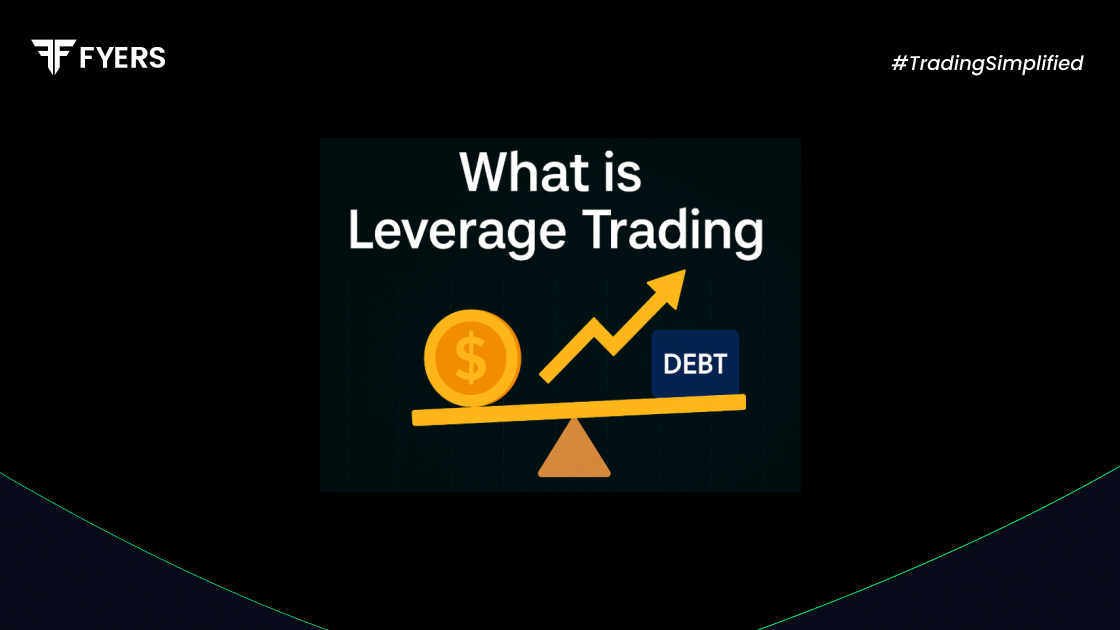

 25 Sep, 2025
25 Sep, 2025
 4 mins read
4 mins read

Trading often comes with the thrill of turning small opportunities into big wins. Among the many techniques in the financial world, leverage trading stands out because it lets you do more with less. With the ability to control a much larger position than your capital would normally allow, it can feel like holding a magnifying glass to your trades. Of course, the same magnification that makes profits exciting can also make losses brutal. To use it wisely, traders need both curiosity and caution.
Leverage trading refers to the practice of using borrowed funds to increase the size of a trade. It allows traders to gain exposure to larger positions than their actual capital would permit.
For example, if you have ₹10,000 and trade with 10x leverage, you can take a position worth ₹1,00,000. This significantly boosts profits if the trade moves in your favour. However, losses are equally magnified, making leverage a double-edged sword.
In India, leverage is commonly used in derivatives trading (futures and options) and is regulated by SEBI. Brokers offer different levels of leverage depending on the asset, segment, and current regulations.
Leverage works by allowing traders to use margin, which is a fraction of the total trade value. The broker provides the remaining funds to open the position.
Example:
You have ₹10,000
The broker offers 10x leverage
You take a position worth ₹1,00,000
If the trade gains 2%, your profit is ₹2,000 (20% of your capital). If it falls 2%, you lose ₹2,000. A small price movement, therefore, has a much bigger impact on your capital.
Leverage is expressed in ratios like 5:1, 10:1, or higher depending on the market and regulations.
Leverage offers several benefits that attract traders:
Amplified returns: Small price movements can generate significant profits.
Efficient capital use: You can diversify trades without tying up too much money.
Access to high-value trades: Retail traders can enter expensive markets.
Short-term strategies: Useful for intraday or short-term trades with quick gains.
The same benefits come with serious risks:
Magnified losses: Just as gains grow, losses can wipe out capital quickly.
Margin calls: You may need to add funds if the market moves against you.
Emotional pressure: High leverage can cause stress and rash decisions.
Volatility risk: Sudden swings can trigger automatic closures (stop-outs).
Because of these risks, leverage is not ideal for beginners without strong risk control.
Managing risk is key when trading with leverage:
Use stop-loss orders: Exit trades at predefined loss levels.
Limit leverage: Start with low leverage such as 2x or 3x.
Position sizing: Risk only a small portion of your capital per trade.
Diversify: Avoid putting all capital into a single position.
Monitor margin: Keep track of available margin to avoid calls.
Effective risk management ensures that traders not only avoid big losses but also preserve capital for long-term success.
Leverage trading is a bit like walking a tightrope. The view is spectacular, and the rewards can be exhilarating, but one misstep can be costly. Used carefully, it helps traders stretch limited capital into meaningful opportunities, but overconfidence can turn it into a quick route to ruin. The secret lies in balance. Respect the risks, keep your safety nets ready with risk management, and leverage can be a powerful ally rather than a dangerous foe.
Yes, leverage trading is legal in India and regulated by SEBI. Brokers offer leverage in different segments such as futures, options, and intraday equity trading within prescribed limits.
Beginners should stick to low leverage, like 2x or 3x. This reduces risk while they learn the market. High leverage can lead to heavy losses for inexperienced traders.
They are related but not identical. Margin is the deposit you make to open a position, while leverage is the ratio of total exposure to margin. Using margin allows you to leverage your trades.
Avoid trading with leverage during periods of extreme volatility, major news events, or if you are trading without stop-loss orders. It should also be avoided when trading emotionally or without a plan.
Calculate your Net P&L after deducting all the charges like Tax, Brokerage, etc.
Find your required margin.
Calculate the average price you paid for a stock and determine your total cost.
Estimate your investment growth. Calculate potential returns on one-time investments.
Forecast your investment returns. Understand potential growth with regular contributions.